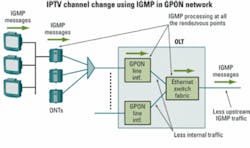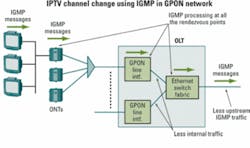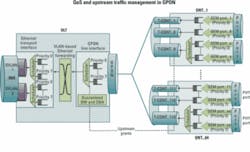GPON provides faster, smarter video transport
By Sayeed Rashid and Rob Parsons
There is today an increased expectation for video quality, choice, and the ability to receive multiple video streams simultaneously in a single household. The demand for digital television and high-definition television (HDTV) is rising quickly, with at least one HDTV set already in more than 10% of U.S. homes. Meanwhile, today’s consumer can produce as well as consume video content-all at the same time. Video delivery over the Internet makes possible the widest distribution of even the most niche-centric content.
In this environment, one can easily foresee that consumers will soon be able to select channels or content from configurable program guides they create themselves, which will change the video landscape because users won’t be locked into a particular service package. Content will be recorded onto a DVR, played at the consumer’s leisure, and seamlessly transported from the TV to the PC, mobile phones, and PDAs.
For the service provider, offering these services will require significant changes to the legacy network--and the biggest change is the need for all-IP broadband access with plenty of bandwidth. Copper-based access infrastructures that were built decades ago are bandwidth limited-and any restriction of the network’s ability to offer a complete services bundle puts providers at a competitive disadvantage. Market research shows that video is the anchor service that guides the consumer’s choice of other services, such as broadband data and voice. In other words, there’s a strong correlation between whoever the consumer chooses for video and who provides other services like data and voice.
Making the move to an IP-based, all-digital network for all services will require a network transformation, because there is a significant technical impact when video is introduced into access networks. First, converging voice, data, and video onto a single all-IP infrastructure requires access networks to become much “smarter.” Making the access network smarter requires an evolution from a pure transport mechanism to enabling the differentiation and prioritization of different types of traffic. Access control (which subscribers can get which channels) to IPTV channels is another “smarter” role access networks can play. Smarter also means having the ability to cost-effectively scale bandwidth and throughput performance.
Second, fiber must be introduced to transport the huge amounts of data generated by the addition of next-generation video services. Whether circumstances dictate taking fiber to the node, curb, or directly to the home, it’s the only medium that offers nearly unlimited bandwidth capacity for the future.
Scalability, quality of service (QoS), and security are key features of the emerging smarter and faster fiber access network. While the obvious advantage of optical fiber lies in its tremendous bandwidth capacity, it must be matched with electronics that can tap that bandwidth cost-effectively, without compromising QoS and security. The correct access technology must be chosen to accommodate the convergence of services and their capacity demands-and gigabit passive optical network (GPON) is quickly emerging as the technology of choice.
GPON provides the critical element for a network with all the right pieces: IP transport, converged services, access network intelligence, and the benefits of optical fiber. While there are several FTTH technologies available today, GPON is the most ideal because it builds on the strengths of earlier technologies, such as broadband PON (BPON) and Ethernet PON (EPON). GPON combines efficient Ethernet transport with QoS and security. The cost economics of Ethernet and a robust PON protocol that has the highest line rates gives GPON a distinct edge over other technologies.GPON features 2.5-Gbit/sec downstream and 1.2-Gbit/sec upstream line rates-higher than any FTTH technology available today and more than twice the bandwidth capacity of EPON and 4× that of BPON. It provides the longest optical reach (20 km typical with 60 km maximum), the highest split ratio (1×64), and the best bandwidth efficiency available for Ethernet traffic-around 94% efficiency compared to 73% for EPON. Additionally, work is progressing toward incorporating WDM technology into GPON to further increase bandwidth by adding additional wavelengths.
Scalability for IP video not only requires scalable bandwidth, but also scalability for high throughput performance in forwarding/switching and high performance for control signaling that allows video channel switching. The core GPON technology standards only relate to the bandwidth scalability, but real-world implementation of GPON for mass-scale IP video requires scalability on all fronts.
IP video traffic is distributed to thousands of customers over many GPON interfaces from an access node at the central office (CO), typically called the optical line terminal (OLT). Hundreds of live broadcast channels, along with potentially high penetration of video-on-demand (VoD), are required. An increasing proportion of these channels or content will likely be HDTV, requiring about 10 Mbits/sec with MPEG4 compression. A video-optimized GPON access node performs switching and forwarding of Ethernet packets at wire-speed with a nonblocking fabric. It provides scalable uplink capacity in the tens of gigabits. The GPON optical network terminals (ONTs) at each home are scalable for delivering throughput capacity in the several hundreds of megabits per second and approaching a gigabit.Because of its basic point-to-multipoint nature, GPON can easily multicast live broadcast video. A specific virtual port within the GPON is dedicated for all multicast traffic. Branches to the multicast tree are added or deleted, as users switch channels. When no one on the GPON is watching a channel, the branch is deleted. When the first user starts watching, a channel is added. A channel is replicated at rendezvous points within the access network as it works its way to those subscribers requesting the channel. With thousands of users and hundreds of channels, the scalability for IP video control becomes just as important as bandwidth and QoS for providing a good user experience.
Internet group management protocol (IGMP) is used in IP video to switch channels. Figure 1 shows how IGMP control messages are handled in GPONs. For greater scalability, each rendezvous point has the ability to process IGMP messages and send them further upstream only when the requested channel is not available at that point. This greatly reduces the upstream control message flow and access bandwidth requirements.
For example, if we assume a multicast efficiency of 60% at each rendezvous point, two IGMP messages per channel change, four active channels per set-top box (STB), three STBs per ONT, 64 ONTs per PON, and 40 PONs per OLT, then IGMP processing at rendezvous points reduces IGMP traffic load toward the upstream network from 61,440 IGMP messages to 3,933. Upstream IGMP traffic is reduced more than 15× using distributed IGMP processing and results in improved scalability and performance.
Another important attribute of GPON is its ability to carry RF video over a dedicated wavelength, should a network provider wish to deploy legacy RF video. The point-to-multipoint topology in GPON is ideal for RF video that broadcasts all channels to all users and uses the STB or TV to tune to the right channel. IP video can be provided instead of or to complement RF video. Since each uses separate wavelengths, there is no contention for bandwidth.
Video requires very different QoS from other services like high-speed Internet. For example, live video broadcast requires high bandwidth and limits on delay and jitter. VoD requires high bandwidth, but with less stringent delay and jitter. It allows the use of statistical guarantees.
Ensuring QoS means proper traffic management across the network. So how does GPON stack up when it comes to delivering QoS? With its ability to support different types of transmission containers (T-CONTs) designed for different traffic types within the PON, it stacks up better than the competing EPON. Both EPON and GPON systems can perform traffic scheduling at the OLT and ONTs based on IEEE 802.1p-defined Ethernet traffic priority classes. The schedulers can send higher-priority traffic, like voice and video, ahead of other lower-priority traffic.
What distinguishes GPON is its ability to use different types of T-CONTs for different types of traffic. As shown in Figure 2, traffic flows with different priorities-identified by virtual ports called GPON Encapsulation Mode (GEM) Port IDs-can be mapped to these T-CONTs. It can potentially completely isolate one traffic type from another. This is important because all PONs are point-to-multipoint and traffic scheduling in the terminals alone is not good enough, particularly in the upstream. There can be ONTs with only low-priority traffic and other ONTs with only high-priority traffic on the same PON.
The T-CONTs in GPON ensure that higher-priority traffic gets higher priority across the whole PON and not just in one terminal. While QoS for downstream video broadcast can be ensured just by traffic schedulers at the OLT, the T-CONTS can reserve bandwidth and ensure low latency for upstream video control traffic. They are also critical for all bidirectional services, such as video conferencing and voice, which require strict limits on delay and jitter. They can also guarantee a minimum bandwidth while allowing dynamic bandwidth redistribution for traffic bursts for high-speed data services.
A GPON can be viewed as a scalable Layer 2 switch with some Layer 3 awareness. GPON terminals (OLTs and ONTs) perform 802.1p-based traffic prioritization along with the T-CONT bandwidth assignments mentioned previously. Service traffic is aggregated and forwarded based on VLAN tags that are applied by the home network and the upstream core network or by the GPON terminals (i.e., OLT/ONT).
GPON enables the building of a switched IPTV access network that is highly scalable and maintains QoS without the complexity or additional cost of a Layer 3 routed network. However, some minimum Layer 3 functions are essential to provide additional flexibility and security, such as dynamic host configuration protocol (DHCP) relay, address resolution protocol (ARP) proxy, and the ability to map differentiated services code point (DSCP) traffic priorities to 802.1p-based priority tags.
There are different layers of security in a GPON to protect against attacks initiated from inside the network and malicious users. First, the network elements are secured. For example, user authentication and authorization can be enforced using an external database through the use of the remote authentication dial-in user service (RADIUS) protocol. Local access is also controlled by valid operator authentication. Physical access to the customer-located ONT is restricted by the enclosure to prevent malicious use. All ONTs go through initialization processes that validate serial numbers as authentic.
Second, GPON can provide PON-layer security by encrypting the payload using the Advanced Encryption Standard (AES). Third, the user ports are authenticated using 802.1x authentication. A RADIUS server is used to authenticate the port, and no data can be exchanged before the port is opened.
Beyond the user port, security is extended in a GPON to validate the connected hosts, servers, and traffic type. For example, DHCP option 90 is used to authenticate DHCP messages from DHCP servers for protection against denial-of-service attacks from bogus DHCP servers. DHCP option 82, which inserts the subscriber’s circuit ID in the DHCP requests, can be used to implement security and address assignment policies. The DHCP relay agent in a GPON access node can send a unicast message for a preconfigured DHCP server when it receives a broadcast DHCP request from a connected host. This avoids the possibility that a malicious DHCP server can respond to the request instead of the valid server.
Filtering can be done for invalid traffic at Layer 2 using a secured MAC learning scheme for the forwarding database. It can limit the maximum number of MAC addresses per port, prevent the learning of duplicate MAC addresses on different ports in the same VLAN, and eliminate broadcast storms. In addition, the GPON blocks direct Layer 2 user-to-user communication to protect the network and limit unauthorized use. User-to-user communication is only allowed via the Layer 3 routed network.
Security offered for IP video extends much further than the GPON and is provided at all the end-to-end network elements. In addition, content security, or copyright protection, is provided by end-to-end protocols implemented in the video terminals (e.g., STB) and headend equipment.
The success of IP video is inseparable from the continued success and growth of broadband. Video is already overlapping into every form of communication, including telephones and the Internet. As video, voice, and data are integrated over a converged broadband access network, the biggest challenge for the service providers will be how to increase the network performance and bandwidth while keeping down costs.
GPON meets these challenges and provides the best platform for offering quality, cost-effective, and scalable IPTV to consumers. While GPON is a standards-based technology, its implementation in the access network to deliver robust IPTV services requires constant innovation and many enhancements from the supplier community.
Fiber is the only way to provide the bigger pipes necessary as technology moves forward. The evolution of the fiber access architecture will undoubtedly vary from market to market. As fiber reaches ever closer to the end user, GPON is shaping up to be the most dominant platform-not only for IP video delivery but for the full spectrum of emerging services. While fiber gives us the pipe, it is the GPON technology that turns it into a smart pipe with scalability, QoS, security, and ease of operation. The key to solving the dilemma of more bandwidth and less cost is the use of smarter and faster broadband enabled by GPON.Sayeed Rashid is senior marketing manager and Rob Parsons is a systems engineer for Alcatel-Lucent’s Access Networks Division (www.alcatel-lucent.com), headquartered in Raleigh, NC.


